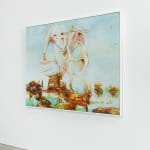-
Artworks









Harbinger, 2022
Oil and ink on canvas58 x 72 x 1 1/2 in.
147.3 x 182.9 x 3.8 cm$ 125,000.00Further images
-
(View a larger image of thumbnail 1
)

-
(View a larger image of thumbnail 2
)

-
(View a larger image of thumbnail 3
)

-
(View a larger image of thumbnail 4
)

-
(View a larger image of thumbnail 5
)

-
(View a larger image of thumbnail 6
)

-
(View a larger image of thumbnail 7
)

-
(View a larger image of thumbnail 8
)

-
(View a larger image of thumbnail 9
)

In his 'Figures' paintings, which are exhibited in the first gallery, Ritchie harnesses the GANs to produce gestural echoes of figurative portraiture that resolve and dissolve before the eyes of...In his "Figures" paintings, which are exhibited in the first gallery, Ritchie harnesses the GANs to produce gestural echoes of figurative portraiture that resolve and dissolve before the eyes of the viewer. Indeed, eyes proliferate within the compositions themselves–a function of the program’s efforts to mirror human thought. As Ritchie notes, “evolutionarily, we are wired to look for eyes first–the GANs is trying to simulate our own visual pathways.” Ritchie pushes into this further with his own compositional choices, fleshing out ghostly visages from the places in which the software glitched and blistered. For Ritchie, the glitch in the matrix is a place of possibility and interpretation.
In the artist’s hands, the idea of artificial intelligence becomes highly subjective, allowing him to play with a personal art history. The resulting paintings feel inhabited by the marks that make them, a summoning of ghostly forces through technological means–from the apocalyptic visions of Hieronymous Bosch and the spiritual abstractions of Georgiana Houghton, to the idiosyncratic expressionism of James Ensor and Paul Nash, and the biomorphic figuration of Max Ernst and Arshile Gorky. Ritchie holds together the weight of histories embodied within the painted mark, while creating emancipatory and interpretative possibilities.Exhibitions
Matthew Ritchie, "A Garden in the Flood", Frist Art Museum, Nashville, TN, Nov 11, 2022–Mar 5, 2023.
-
(View a larger image of thumbnail 1
)








